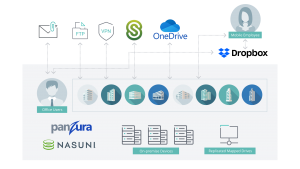
Where is Your Center of the Universe for Business Content?
Five hundred years ago, astronomers believed the Earth was at the center of the universe. They calculated the orbits of the planets, the sun, and other stars based on this truth. Turns out, these calculations were not very accurate and astronomers had to repeatedly and incorrectly model their equations to conform with this truth.
That was until Nicolaus Copernicus challenged the premise of the Earth at the center of the universe and posited the Sun to be at the center of the solar system. This pioneering and bold discovery paved the way for mathematicians and modern astronomers to formulate more predictable equations about the orbits of planets, duration of seasons, and much more.
Copernicus’ work has an interesting parallel with the file-sharing decisions that system administrators make today.

Many companies still consider their on-premises storage platforms on their NAS, SAN servers, and NAS-centric solutions like Nasuni and Panzura as the “center of the universe” for business content. However, to meet the requirements of a distributed and a growing workforce, they also invest in a combination of cloud solutions such as SharePoint Online, Google, Box, and Dropbox. We have seen this cloud adoption pick up pace, as the world’s health crisis has further accelerated the need to support work-from-home employees. Even traditional brick-and-mortar companies are investing enormous IT budgets to support this new work model.
The major decision facing IT leaders today is whether to continue to leave content in on-premises repositories while allowing collaboration in cloud platforms or to migrate content completely to a cloud platform that facilitates internal and external collaboration.
Numerous studies exist that highlight the cost advantages of cloud storage and SaaS solutions over on-premises storage. Simply put, it costs less to store a TB of data in the cloud compared to an on-premises environment. However many companies still have not made the transition to the cloud.
Why is that?
The biggest challenges are the perceived cost and time requirements to migrate large data sets from on-premises storage servers, often located across multiple offices - without any disruption to the business.
Now imagine the increase in cost and complexity when you throw in shadow cloud applications, like Google, Box, or Dropbox, as employees adopt cloud-collaboration platforms to more effectively share files. As users work in these new applications, files created, saved, and shared result in further fragmentation of content, adding overhead for users and administrators trying to consolidate this data within the company’s primary storage. Most often, data becomes fragmented beyond on-premises storage, and into different cloud stores. The result is that IT quickly loses visibility and control of company content, significantly increasing the risk to a company’s proprietary data. This forces IT administrators to invest more money in governance solutions to audit users and protect against data theft.
Most of our customers are in this predicament when they initiate early discussions and often the first step is shifting their center of the universe from on-premises storage to Egnyte. Egnyte’s top-down folder hierarchy and centralized security model helps system administrators logically map their distributed content repositories into meaningful top-level folders. Most customers set up department folders, project folders, or other workflow folders as their top-level folders. As a next logical step, customers centralize Active Directory users and security groups on Egnyte using our Active Directory synchronization tools and configure Egnyte with their custom third-party SSO providers. These structural shifts enable the consolidation of content across distributed platforms (cloud and on-premises) into a single, unified cloud platform, while enabling the migration of data into Egnyte in a phased manner.
One of the most notable examples of a large-scale migration was of a customer who recently moved to Egnyte with more than 75 regional offices and nearly 150 TB of data distributed across Windows Servers and other content repositories. Many regional offices had fewer than 50 Mbps internet connection. Using a combination of our Professional Services’ expertise and powerful migration tools, the customer migrated all their content to Egnyte with zero business disruptions across their global offices - all in a timeline that allowed the customer to quickly retire their legacy systems without incurring wasted maintenance costs.
Customers, like the one mentioned above, reap the benefits of migrating to a unified content repository almost immediately after the cutover. System administrators receive a single-pane-of-glass view into company content for audit and governance, while users can globally access and share their content both internally and externally, and with confidence. Keeping users in mind, customers often enable third-party SaaS integrations, such as Microsoft Online, Google Workspace, Docusign, SalesForce, or Autodesk BIM-360, providing users with the flexibility of working on the latest SaaS applications.
Just as early astronomers challenged thinking around the center of the universe, NAS-centric solutions should also be challenged. The fundamental premise of centralizing content and governance controls has stood the test of time since the early days of IBM servers. Sadly, many undermine the merit of this simple, yet powerful, premise in the deluge of big data, a globally distributed workforce and the emergence of user-centric cloud applications that entrust increased file-sharing controls to end users.
Egnyte is perhaps one of the few, unique cloud solutions that intersects the fundamentals of a unified content repository and centralized governance with distributed file sharing and collaboration.
May the single source of truth continue to shine!





